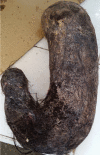[A rare cause of mechanical occlusion in children: a case report]
- PMID: 33889237
- PMCID: PMC8033196
- DOI: 10.11604/pamj.2021.38.71.27634
[A rare cause of mechanical occlusion in children: a case report]
Abstract
Gastrointestinal (GI) bezoars are aggregates of undigested material found in the GI tract. Trichobezoar is the most common type of bezoars and consists of ingested hair, carpet fibers or fitted carpet fibers. They are mainly located in the gastric region, rare forms extend to the duodenum or small intestine and are described as Rapunzel syndrome. Typical CT imaging features play a diagnostic and prognostic role. We report the case of a 13-year-old girl hospitalized for occlusive syndrome due to trichobezoar.
Les bézoards correspondent à la concrétion de substances ingérées non digestibles dans le tractus gastro-intestinal. Le trichobézoard est la forme la plus fréquente des bézoards, et correspond à l'ingestion de cheveux, poils ou fibres de tapis ou moquette. Principalement de localisation intra-gastrique, il existe des formes rares d'extension duodénale ou à l'intestin grêle définies par le syndrome de Rapunzel. L'imagerie notamment scanographique est typique et joue un double rôle diagnostique et pronostique. Nous rapportons le cas d'une enfant âgée de 13 ans hospitalisée pour un syndrome occlusif sur un trichobézoard.
Keywords: Bezoar; Rapunzel syndrome; case report; occlusion.
Copyright: Amina Mouffak et al.
Conflict of interest statement
Les auteurs ne déclarent aucun conflit d'intérêts.
Figures





Similar articles
-
Rapunzel syndrome in adult with mysterious presentation: a rare case report with literature review.Trop Doct. 2019 Apr;49(2):133-135. doi: 10.1177/0049475519826477. Epub 2019 Feb 5. Trop Doct. 2019. PMID: 30722745 Review.
-
Recurrent Rapunzel Syndrome in an Adolescent Female.Am Surg. 2023 Aug;89(8):3665-3667. doi: 10.1177/00031348231173942. Epub 2023 May 3. Am Surg. 2023. PMID: 37132419
-
Rapunzel syndrome: an infrequent cause of severe iron deficiency anemia and abdominal pain presenting to the pediatric emergency department.BMC Pediatr. 2018 Apr 4;18(1):125. doi: 10.1186/s12887-018-1097-8. BMC Pediatr. 2018. PMID: 29614986 Free PMC article.
-
[Rapunzel Syndrome Removed with Enteroscopy in a Child].Korean J Gastroenterol. 2019 Jul 25;74(1):42-45. doi: 10.4166/kjg.2019.74.1.42. Korean J Gastroenterol. 2019. PMID: 31344771 Korean.
-
Rapunzel syndrome: a case report and review.J Gastrointest Surg. 2008 Sep;12(9):1612-4. doi: 10.1007/s11605-007-0408-4. Epub 2007 Nov 20. J Gastrointest Surg. 2008. PMID: 18027058 Review.
Cited by
-
Rapunzel syndrome: An infrequent cause of paediatric mechanical occlusion.Afr J Paediatr Surg. 2023 Jan-Mar;20(1):71-73. doi: 10.4103/ajps.ajps_81_21. Afr J Paediatr Surg. 2023. PMID: 36722573 Free PMC article.
-
Rapunzel Syndrome: Clinical, Diagnostic and Forensic Aspects in Related Deaths-A Review of the Literature.J Clin Med. 2024 Dec 8;13(23):7464. doi: 10.3390/jcm13237464. J Clin Med. 2024. PMID: 39685922 Free PMC article. Review.
References
-
- Mehta M, Patel RV. Intussusception and intestinal perforations caused by multiple trichobezoars. J Pediatr Surg. 1992 Sep;27(9):1234–1235. - PubMed
-
- Ibuowo AA, Saad A, Onkonkowo T. Giant gastric trichobezoar in a young female. Int J Surg. 2008 Dec;6(6):4–6. - PubMed
-
- DeBakey M, Ochsner A. Bezoars and concretions: comprehensive review of literature with analysis of 303 collected cases and presentation of eight additional cases. Surgery. 1939 Jan;5(1):132–160.
-
- Roche C, Guye E, Coinde E, Galambrun C, Glastre C, Halabi M, et al. Trichobézoard: à propos de 5 observations. Arch Pediatr. 2005 Nov;12(11):1608–1612. - PubMed
